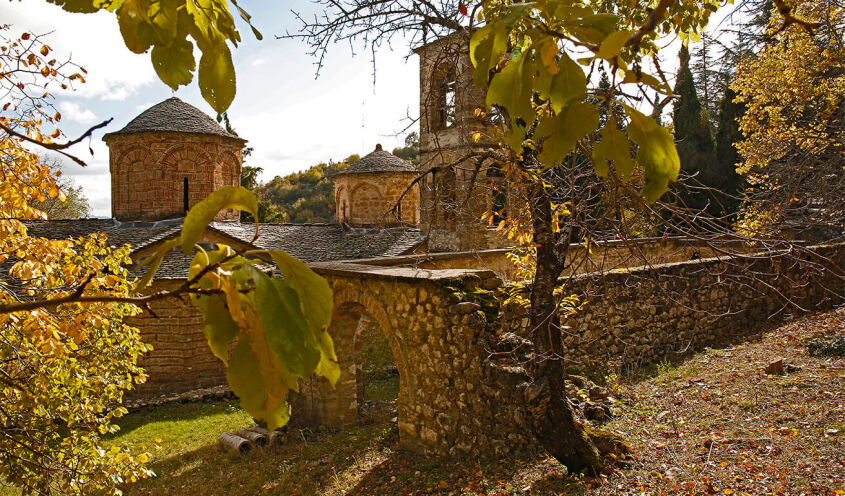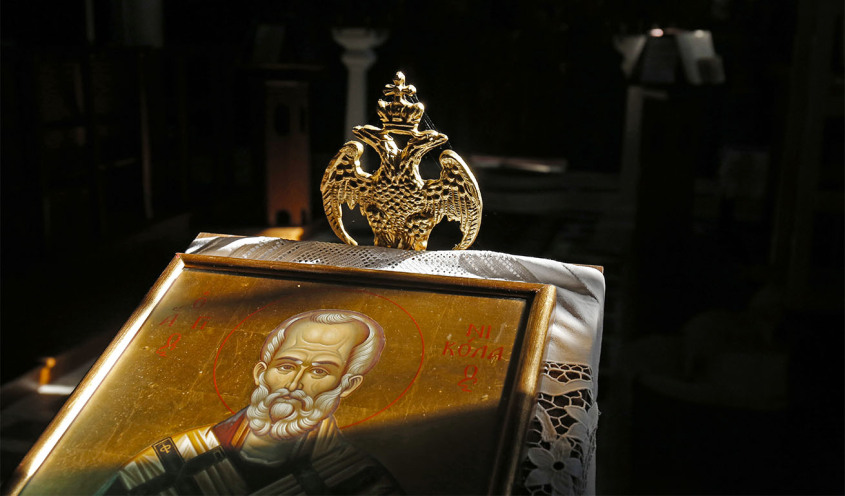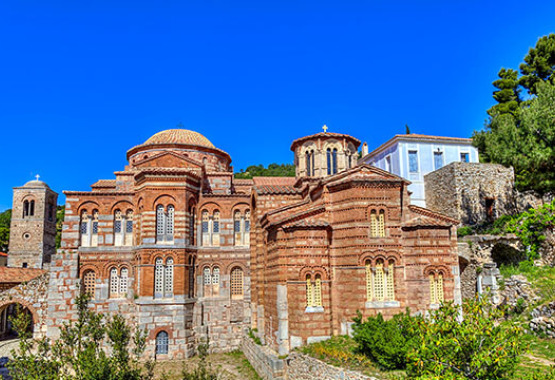
GREVENA
The guilds of stone masons and of all other construction trades have left their imprint on the religious buildings, which stand as testimony to the strong religious sentiment in the area. In almost every village there is a church or a nearby monastery, which tells a story, reaching up to eight centuries back in time. Great folk artisans, builders, iconographers and wood carvers, from the stone masons’ villages (Mastorochoria) near Grevena, along with those from Konitsa or Kozani area, have created elegant works of art, which to this day are awe-inspiring.
The Monastery of Zavorda or Holy Patriarchal and Stavropegic Monastery of Saint Nikanoras (Transfiguration of the Saviour) of Zavorda (full name) is located about 22 kilometres north of Deskati, very close to the banks of Aliakmonas river. It was built in the first half of the 16th century by Saint Nikanoras, who lived as an ascetic in the area. After having experienced a vision, he discovered the icon of the Transfiguration of Christ, in whose honour the monastery was named. The icon is still kept in the katholikon (the main church of the monastery). It has exceptional murals, of different eras and styles, with some of them attributed to the great Theban painter Franco Catelano, who lived in the 16th century. Many other religious exhibits and sacred relics are also kept in the monastery. The group of buildings is surrounded by a high stone wall. The monastery is open in the morning and in the afternoon; however, this male monastic community follows the Mount Athos rule banning entry to women.
The 12th century Monastery of the Dormition of Theotokos of Torniki is located very close to the Aliakmonas River. It is believed to have been connected with the well-known Byzantine Torniki family of that century.
The two-storey building has its katholikon on the ground floor and another church on the first floor. It had to be moved 140 metres higher than its original position, when the Ilarionas dam was built on the Aliakmonas River. It has excellent religious paintings from 1481 and 1730, and offers a wonderful view of the river. It can be visited only on Sunday mornings and holidays, while for the remaining days it is necessary to consult with the Ephorate of Antiquities in Grevena.
The Monastery of the Transfiguration of the Saviour, near Dasochori, Deskati, was built before 1797, and had flourished until the beginning of the 20th century, with a large monastic community who also contributed in many ways to the local community. It also housed the “kryfo scholio”- a secret school for teaching the Greek language and Christian doctrine, when the Greeks lived under the Ottoman rule.
It has been restored, thanks, mainly, to the efforts of the nun Mariam, the only person living in the monastery. It can be visited in the morning.
The Monastery of the High Commanders & Archangels Michael and Gabriel, on the fringes of Taxiarchis village, northeast of Grevena town, was built in the first half of the 19th century and is shaped like a fort. The katholikon walls and the matroneum section are painted with beautiful murals; today, the monastery is inactive.
Also inactive is the Monastery of the Annunciation to Theotokos (Our Lady), as it is under restoration. Built in a stunning location near the Bounasia peak, in the area of Paliouria village, it was founded in the 14th century and remained active until 1935, with a significant intellectual output and participation in Greece’s national struggles.
The Monastery of the Dormition of Theotokos aka Panagia Spiliotissa was founded in 1633. It is located on the fringes of Spilaio village, and it is, today, without a monastic community. The restored katholikon of the monastery is painted with murals, which are exquisite samples of folk art by craftsmen from western Macedonia and Epirus.
Visitors to the picturesque Vlach village of Perivoli, should also drop by the post-Byzantine church of Agios Nikolaos just outside the village. It is actually the katholikon of the like-named monastery.
The impressive in size Megali Panagia Church is a three-aisled basilica, built in the early 19th century and dedicated to the Dormition of the Virgin. It is the metropolitan church of Samarina village. In addition to the church’s rich iconography created by local folk painters, the intricately-carved gilded iconostasis is eye-catching, too, as are the pulpit and the Bishop’s throne. A special feature of the church is a large pine tree, which has been growing through the conch (the domed roof of the semicircular apse) in the sanctuary for over 100 years.
The church of Agia Paraskevi (the katholikon of the monastery of the same name) and the neighbouring church of the Transfiguration of the Saviour are on the road to Distrato village; they are definitely worth a visit for their architecture and fine murals.
Painters from Samarina village are believed to have crafted the icons in the Church of Agios Nikolaos, built in 1864, in Kalloni village, since the style used is very similar to their other works of art.
The Monasteries of Grevena
Stone-built monasteries, elegant craftsmanship of folk artisansThe guilds of stone masons and of all other construction trades have left their imprint on the religious buildings, which stand as testimony to the strong religious sentiment in the area. In almost every village there is a church or a nearby monastery, which tells a story, reaching up to eight centuries back in time. Great folk artisans, builders, iconographers and wood carvers, from the stone masons’ villages (Mastorochoria) near Grevena, along with those from Konitsa or Kozani area, have created elegant works of art, which to this day are awe-inspiring.
The Monastery of Zavorda or Holy Patriarchal and Stavropegic Monastery of Saint Nikanoras (Transfiguration of the Saviour) of Zavorda (full name) is located about 22 kilometres north of Deskati, very close to the banks of Aliakmonas river. It was built in the first half of the 16th century by Saint Nikanoras, who lived as an ascetic in the area. After having experienced a vision, he discovered the icon of the Transfiguration of Christ, in whose honour the monastery was named. The icon is still kept in the katholikon (the main church of the monastery). It has exceptional murals, of different eras and styles, with some of them attributed to the great Theban painter Franco Catelano, who lived in the 16th century. Many other religious exhibits and sacred relics are also kept in the monastery. The group of buildings is surrounded by a high stone wall. The monastery is open in the morning and in the afternoon; however, this male monastic community follows the Mount Athos rule banning entry to women.
The 12th century Monastery of the Dormition of Theotokos of Torniki is located very close to the Aliakmonas River. It is believed to have been connected with the well-known Byzantine Torniki family of that century.
The two-storey building has its katholikon on the ground floor and another church on the first floor. It had to be moved 140 metres higher than its original position, when the Ilarionas dam was built on the Aliakmonas River. It has excellent religious paintings from 1481 and 1730, and offers a wonderful view of the river. It can be visited only on Sunday mornings and holidays, while for the remaining days it is necessary to consult with the Ephorate of Antiquities in Grevena.
The Monastery of the Transfiguration of the Saviour, near Dasochori, Deskati, was built before 1797, and had flourished until the beginning of the 20th century, with a large monastic community who also contributed in many ways to the local community. It also housed the “kryfo scholio”- a secret school for teaching the Greek language and Christian doctrine, when the Greeks lived under the Ottoman rule.
It has been restored, thanks, mainly, to the efforts of the nun Mariam, the only person living in the monastery. It can be visited in the morning.
The Monastery of the High Commanders & Archangels Michael and Gabriel, on the fringes of Taxiarchis village, northeast of Grevena town, was built in the first half of the 19th century and is shaped like a fort. The katholikon walls and the matroneum section are painted with beautiful murals; today, the monastery is inactive.
Also inactive is the Monastery of the Annunciation to Theotokos (Our Lady), as it is under restoration. Built in a stunning location near the Bounasia peak, in the area of Paliouria village, it was founded in the 14th century and remained active until 1935, with a significant intellectual output and participation in Greece’s national struggles.
The Monastery of the Dormition of Theotokos aka Panagia Spiliotissa was founded in 1633. It is located on the fringes of Spilaio village, and it is, today, without a monastic community. The restored katholikon of the monastery is painted with murals, which are exquisite samples of folk art by craftsmen from western Macedonia and Epirus.
Visitors to the picturesque Vlach village of Perivoli, should also drop by the post-Byzantine church of Agios Nikolaos just outside the village. It is actually the katholikon of the like-named monastery.
The impressive in size Megali Panagia Church is a three-aisled basilica, built in the early 19th century and dedicated to the Dormition of the Virgin. It is the metropolitan church of Samarina village. In addition to the church’s rich iconography created by local folk painters, the intricately-carved gilded iconostasis is eye-catching, too, as are the pulpit and the Bishop’s throne. A special feature of the church is a large pine tree, which has been growing through the conch (the domed roof of the semicircular apse) in the sanctuary for over 100 years.
The church of Agia Paraskevi (the katholikon of the monastery of the same name) and the neighbouring church of the Transfiguration of the Saviour are on the road to Distrato village; they are definitely worth a visit for their architecture and fine murals.
Painters from Samarina village are believed to have crafted the icons in the Church of Agios Nikolaos, built in 1864, in Kalloni village, since the style used is very similar to their other works of art.














